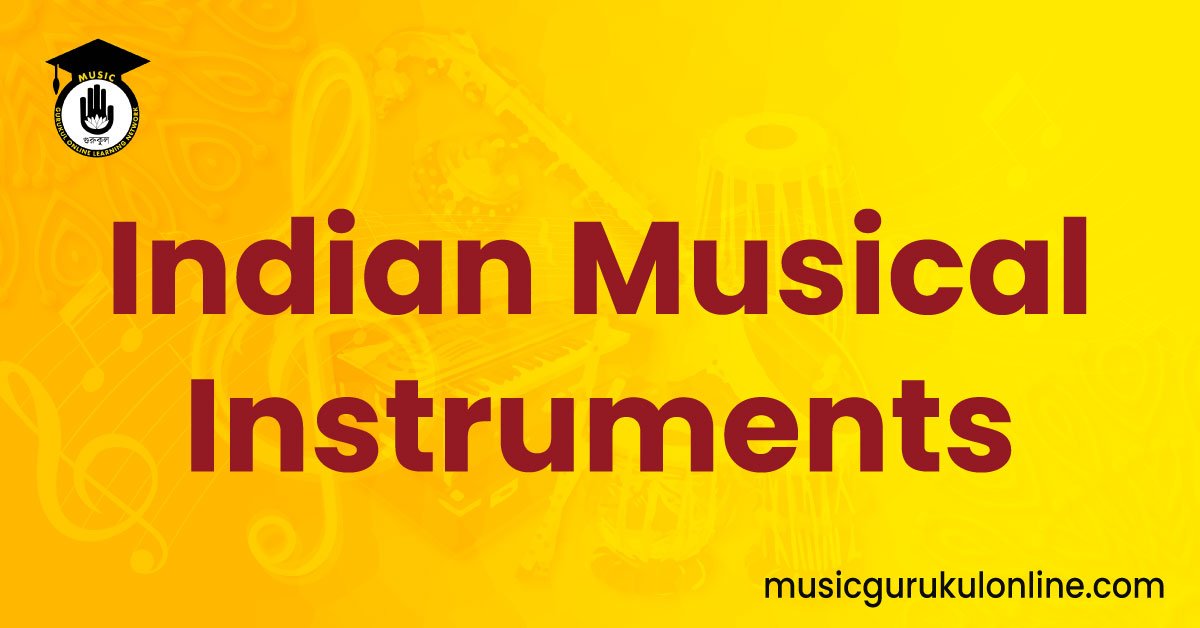Indian Musical Instruments: The most perfect instrument for creating music is no doubt the human voice. All other instruments try to imitate or approximate its spontaneous appeal and mastery. But through the centuries several instruments have been developed presenting a great variety in sound and the technique of playing. Scholars say that there are over two hundred varieties of musical instruments prevalent in India, but those which are used for performances of classical music are much less in number. We will now listen to some of the important ones of Hindustani music.

Table of Contents
Vadya [ বাদ্য ], Indian Musical Instruments
The general term for musical instruments in India is Vadya. That means what you play to produce music.
Tat Vadya, Indian Musical Instruments
The string instruments are known as Tat Vadya. The string can be either plucked as in the Sitar or struck as in the Santoor or played with a bow as in the Sarangi.
To describe the various string instruments, it would be advisable to remember their five basic components.
- A stem frame or fingerboard over which the strings are tensioned.
- The strings for playing.
- Two bridges, one, ‘dead’ and the other ‘live’ which are the points of suspension of the strings.
- An air chamber, to which the vibration of the string is transmitted.
- A cover on the air chamber which serves as a membrane, and on which the ‘live’ bridge sits, to transmit the vibrations of the string.
Sitar, Indian Musical Instruments
The sitaris a plucked stringed instrument, originating from the Indian subcontinent, used in Hindustani classical music. The instrument was invented in medieval India and flourished in the 16th and 17th centuries and arrived at its present form in 18th-century India.
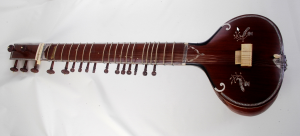
Used widely throughout the Indian subcontinent, the sitar became popularly known in the wider world through the works of Ravi Shankar, beginning in the late 1950s and early 1960s. In the 1960s, a short-lived trend arose for the use of the sitar in Western popular music, with the instrument appearing on tracks by bands such as the Beatles, the Doors, the Rolling Stones and others.
The Sitar has a long slim wooden stem fixed to a hollow gourd as an air chamber. The cover of the air chamber is a thin sheet of wood over which the live bridge sits.
Frets on the stem constitute the fingerboard and the strings are pressed down by the left-hand fingers to produce different notes. The plucking is done with a wire plectrum fixed on the tip of the right forefinger.
Lear More about Sitar : Sitar Wiki
Vilayat Khan – Sitar- Raga Shankara
Surbahar, Indian Musical Instruments
The surbahar is over 130 cm (51 inches). It uses a dried gourd as a resonator, and has a neck with very wide frets, which allow a glissando or”meend” of as much as an octave on the same fret through the method of pulling. The neck is made out of toona, or mahogany wood. It has 3-4 rhythm strings (chikari), four playing strings (the broadest 1 mm), and 10 to 11 sympathetic strings.
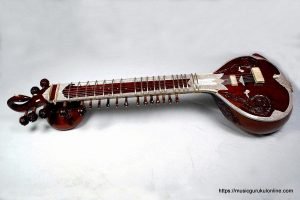
There are two bridges; the playable strings pass over the greater bridge, which is connected to the tabli with small legs, which are glued in place. The sympathetic strings pass over the smaller bridge which is directly glued on the tabli.
The bridges have a slightly curved upper surface parallel to the string that the strings touch when vibrating, which results in a buzzing sound known as jawari. The body of the instrument is similar to that of a sitar, in that it is made of a large dried gourd with a carved wood face on one side and joined to the neck by a carved wooden yoke or “gulu”.
It differs in that most surbahars have a gourd that is larger and tilted 90º so that the bottom of the gourd is to the back of the instrument, creating a shallower and rounder body for an enhanced bass response.
This is a sort of a bigger Sitar, but lower in pitch. It produces a very deep and resonant sound full of gravity. Though fast going out of fashion it is still played. This is primarily an Alap instrument.
Learn more about Surbahar : Surbahar Wiki
Imrat Khan – Surbahar- Raga Yaman Kalyan
Sarod, Indian Musical Instruments
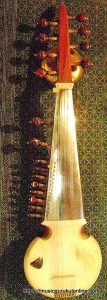
The sarod is a stringed instrument, used mainly in Hindustani music on the Indian subcontinent. Along with the sitar, it is among the most popular and prominent instruments. It is known for a deep, weighty, introspective sound, in contrast with the sweet, overtone-rich texture of the sitar, with sympathetic strings that give it a resonant, reverberant quality. A fretless instrument, it can produce the continuous slides between notes known as meend (glissandi), which are important in Indian music.
The Sarod has a very sparkling, liquid, and rounded sound. The left-hand fingertips, by gliding over the polished steel plate on the fretless fingerboard, produce spectacular Meends or glides from note to note. The air chamber is extended to halfway down the fingerboard, and both make one unit, being carved out of a single block of wood. The cover of the air chamber is tanned hide of goat or lamb.
The conventional sarod is a 17 to 25-stringed lute-like instrument—four to five main strings used for playing the melody, one or two drone strings, two chikari strings and nine to eleven sympathetic strings. The design of this early model is generally credited to Niyamatullah Khan of the Lucknow Gharana as well as Ghulam Ali Khan of the Gwalior-Bangash Gharana. Among the contemporary sarod players, this basic design is kept intact by two streams of sarod playing. Amjad Ali Khan and his disciples play this model, as do the followers of Radhika Mohan Maitra. Both Amjad Ali Khan and Buddhadev Dasgupta have introduced minor changes to their respective instruments which have become the design templates for their followers.
Both musicians use sarods made of teak wood, and a soundboard made of goat skin stretched across the face of the resonator. Buddhadev Dasgupta prefers a polished stainless steel fingerboard for the ease of maintenance while Amjad Ali Khan uses the conventional chrome or nickel-plated cast steel fingerboard. Visually, the two variants are similar, with six pegs in the main pegbox, two rounded chikari pegs and 11 (Amjad) to 15 (Buddhadev) sympathetic strings.
The descendants of Niyamatullah Khan (namely Irfan Khan and Ghulfam Khan) also play similar instruments. Some of the followers of Radhika Mohan Maitra still carry the second resonator on their sarods. Amjad Ali Khan and his followers have rejected the resonator altogether. These instruments are typically tuned to B, which is the traditional setting.
Learn More About Sarod : Sarod Wiki
Ali Akbar Khan – Sarod – Raga Medhavi
Been or Veena, Indian Musical Instruments
The veena, also spelled vina, comprises a family of chordophone instruments from the Indian subcontinent. Ancient musical instruments evolved into many variations, such as lutes, zithers and arched harps. The many regional designs have different names such as the Rudra veena, the Saraswati veena, the Vichitra veena and others.
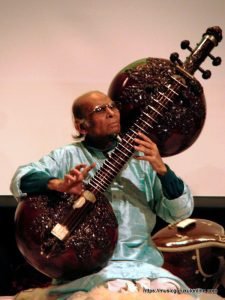
Among the old traditional instruments is the Been or the Rudra Veena. It has two gourds for resonance. Though considered to be a very venerable instrument, it is not very popular nowadays. It is very delicate in its nuances and is said to be the closest to the human voice. Eminently suited to the Dhrupad style of rendering, its popularity has declined along with the Dhrupad.
The North Indian design, used in Hindustani classical music, is a stick zither. About 3.5 to 4 feet (1 to 1.2 meters) long to fit the measurements of the musician, it has a hollow body and two large resonating gourds under each end. It has four main strings which are melodic, and three auxiliary drone strings.
To play, the musician plucks the melody strings downward with a plectrum worn on the first and second fingers, while the drone strings are strummed with the little finger of the playing hand. The musician stops the resonating strings, when so desired, with the fingers of the free hand. In modern times the veena has been generally replaced with the sitar in North Indian performances.
The South Indian veena design, used in Carnatic classical music, is a lute. It is a long-necked, pear-shaped lute, but instead of the lower gourd of the North Indian design, it has a pear-shaped wooden piece. However it, too, has 24 frets, four melody strings, and three drone strings, and is played similarly. It remains an important and popular string instrument in classical Carnatic music.
As a fretted, plucked lute, the veena can produce pitches in a full three-octave range. The long, hollow neck design of these Indian instruments allow portamento effects and legato ornaments found in Indian ragas. It has been a popular instrument in Indian classical music, and one revered in the Indian culture by its inclusion in the iconography of Saraswati, the Hindu goddess of arts and learning.
Zia Mohiuddin Dagar – Been – Raga Chandrakauns
Santoor, Indian Musical Instruments
The Indian santoor instrument is a trapezoid-shaped hammered dulcimer, and a variation of the Iranian Santur. The instrument is generally made of walnut and has 25 bridges. Each bridge has 4 strings, making for a total of 100 strings. It is a traditional instrument in Jammu and Kashmir, and dates back to ancient times. It was called Shatha Tantri Veena in ancient Sanskrit texts.
Among the instruments of folk music, one which has of late become very popular in classical music also is the Santoor. It is of Kashmiri origin. Here the strings are not plucked but struck with two small wooden mallets. Its sound has a light, quick, silvery quality, like a water spring.
Shivkumar Sharma – Santoor – Raga Rageshwari
Sarangi, Indian Musical Instruments
Among the string instruments which are played with a bow, the Sarangi and the Violin are most common and are primarily used as accompanying instruments.
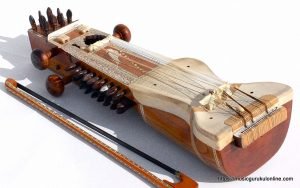
They are believed to be close to the human voice. They follow the main melody and by repeating and reiterating enhance its basic structure. This gives to the composition a sense of richness and fullness.
The Sarangi has its fingerboard and hide-covered air chamber amalgamated into a short oblong box and has catguts for main strings. The Sarangi player has often a very large repertoire of Ragas since his is a supporting instrument.
The trapezoid framework is generally made out of either walnut or maple wood. The top and bottom boards sometimes can be either plywood or veneer. On the top board, also known as the soundboard, wooden bridges are placed, in order to seat stretched metal strings across. The strings, grouped in units of 3 or 4, are tied on nails or pins on the left side of the instrument and are stretched over the sound board on top of the bridges to the right side. On the right side there are steel tuning pegs or tuning pins, as they are commonly known, that allows tuning each unit of strings to a desired musical note or a frequency or a pitch.
Ram Narain – Sarangi – Raga Des
Esraj, Indian Musical Instruments
This is a bow instrument, a sort of a fusion of the Sitar’s fretted fingerboard and the hide-covered air chamber of the Sarangi. The Dilruba is a larger version of the Esraj.
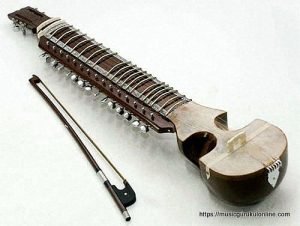
The esraj is an Indian stringed instrument found in two forms throughout the Indian subcontinent. It is a relatively recent instrument, being only about 300 years old. It is found in North India, primarily Punjab, where it is used in Sikh music and Hindustani classical compositions and in West Bengal. The esraj is a modern variant of the dilruba, differing slightly in structure.
The dilruba and its variant, the esraj, had been declining in popularity for many decades. By the 1980s, the instrument was nearly extinct. However, with the rising influence of the “Gurmat Sangeet” movement in an effort to revive the traditional instrumentation of Sikh Kirtan, the instrument has been once again attracting attention. In West Bengal, Rabindranath Tagore made this instrument mandatory for all the students of the Sangeet Bhavan (Music Academy) in Visva-Bharati University (otherwise known as Shantiniketan). Because of this, Esraj is considered the main accompanying instrument for traditional Rabindra Sangeet.
Rana Dhir Roy – Esraj – Raga Shree
Sushir Vadya, Indian Musical Instruments
are The wind instruments are known as Sushir Vadya. The Flute and the Shehnai, are the popular wind instruments in Hindustani music where sound is produced by blowing air into them.
Flute – bansuri, Indian Musical Instruments
A bansuri is a side blown flute originating from the Indian subcontinent. It is an aerophone produced from bamboo, used in Hindustani classical music. It is referred to as nadi and tunava in the Rigveda and other Vedic texts of Hinduism. Its importance and operation is discussed in the Sanskrit text Natya Shastra.
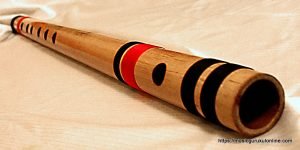
Though very ancient in origin, the flute has only recently risen to the status of a concert instrument. It can acquire a deeply haunting sound. It is made of a hollow bamboo reed. In India, it is closely associated with Lord Krishna and the Raslila at Brindavan.
A bansuri is traditionally made from a single hollow shaft of bamboo with six or seven finger holes. Some modern designs come in ivory, fiberglass and various metals. The six hole instrument covers two and a half octaves of music. The bansuri is typically between 30 centimetres (12 in) and 75 centimetres (30 in) in length, and the thickness of a human thumb. One end is closed, and few centimeters from the closed end is its blow hole. Longer bansuris feature deeper tones and lower pitches. The traditional design features no mechanical keys, and the musician creates the notes they want by tapping the various finger holes.
Hariprasad Chaurasia Flute – Raga Pilu
Shehnai – shahanai, Indian Musical Instruments
The shehnai is a musical instrument, originating from the Indian subcontinent. It is made out of wood, with a double reed at one end and a metal or wooden flared bell at the other end. Its sound is thought to create and maintain a sense of auspiciousness and sanctity and as a result, is widely used during marriages, processions and in temples although it is also played in concerts. It was a part of the Naubat or traditional ensemble of nine instruments found in the royal court. The shehnai is similar to South India’s nadaswaram.
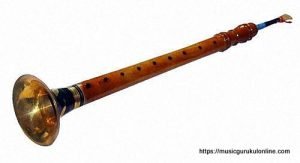
The word Shehnai comes from a Persian word meaning ‘Flute of Royalty’. The Shehnai is used during auspicious and festive occasions. Its sound has a bright pealing clarity. As it is an instrument for auspicious occasions many programs begin with a Shehnai recital. It is capable of producing long sustained notes and demands a great control of breath.
Bismillah Khan – Shehnai – Raga Lalit
Ghana vadya, Indian Musical Instruments
This is the name given to percussion instruments in India. They are primarily instruments of accompaniment for the vocalists and the instrumentalists.
Pakhawaj, Indian Musical Instruments
The Pakhawaj is used primarily for the Dhrupad style. It is a single-piece instrument. It means ‘pure sound-pakka awaj’. It is now losing its earlier popularity. Its sound is deep, heavy, and loud.
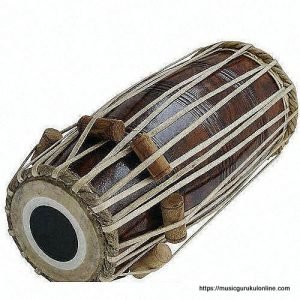
The pakhavaj is a barrel-shaped, two-headed drum, originating from the Indian subcontinent, a variant and descendant of the older mridangam. The kendang of Maritime Southeast Asia is a distant relative of the pakhawaj and other South Asian double-headed drums.
It is the percussion instrument most commonly used in the dhrupad style of Indian classical music and less often used as a rhythm accompaniment for various other sub-forms of music and dance performances (e.g. kathak). Unlike mridangam, it is made of wood and has a low, mellow tone that is quite rich in harmonics. The sides of the pakhawaj are made with animal skin (often goat skin). The pakhavaj players place the instrument horizontally in front of themselves as they sit on the floor with legs crossed.
The players may sometimes place a cushion under the narrower treble face to lift it slightly. A right-handed person places the larger bass-skin on the left side and the treble skin on the right. The bass face tends to be smeared with some fresh wheat dough which acts as the kiran and gives a vivid bass sound to the pakhavaj.
Arjun Shejwal – Pakhawaj
Tabla, Indian Musical Instruments
In the North the Tabla is the most common and popular instrument for accompaniment. It consists of two pieces. There is a popular tale that once a well-known musician of Medieval times wanted to bring down the volume of the accompanying Pakhawaj so that the delicate graces of the Khayal way of singing could be better heard. After reflection, he broke the Pakhawaj into two halves and thus reduced the volume of the sound.
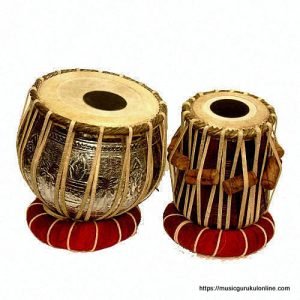
A tabla is a pair of twin hand drums from the Indian subcontinent. Since the 18th century, tabla has been the principal percussion instrument in Hindustani classical music, where it may be played solo, as accompaniment with other instruments and vocals, and as a part of larger ensembles.
Tabla is also frequently played in popular and folk music performances in India, Bangladesh, Pakistan, Nepal, Afghanistan and Sri Lanka. The tabla is also an important instrument in the bhakti devotional traditions of Hinduism and Sikhism, such as during bhajan and kirtan singing. It is one of the main qawali instrument used by Sufi musicians. Tabla also features in dance performances such as Kathak.
The right-hand Tabla, Dayan, is made of wood while the left-hand Tabla, Bayan, is of metal or clay. The sound is sparkling and clear, and while the Dayan is lighter the Bayan is heavier in tone.
Zakir Hussain – Tabla – Teental
Harmonium, Indian Musical Instruments
The Harmonium has become very popular in modern times. While the right-hand presses the keys and thus selects the particular reeds, the left-hand moves a bellow to blow air through them.
As with any other keyboard instrument, the limitation of the Harmonium is that the notes are absolutely fixed and it is extremely difficult to give the effect of the Shrutis. It is for this reason that it is not considered to be a strictly classical instru ment though, in the hands of a good player, it can produce amazing sound effects. Singers often use it, for background accompaniment.
Sohanlal Sharma – Harmonium – Raga Nat Bhairav [ Not available online at this moment] Alternate is :
Read More:
